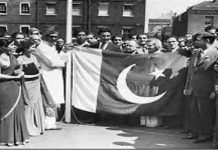Shahid and his friends shout with joy as the second wicket falls. As they do every day, the five boys stack rocks to mark the wickets so they can play cricket on the busy narrow street in front of their houses.
This is no easy game, as the boys deftly dodge the traffic on the street like thousands of other children in Karachi.
The streets of Karachi are dangerous, but these youngsters don’t have an alternative. Most playgrounds in the city have been gobbled up by the land mafia over the years.
With a population of 14.91 million (census 2017) and increasing every year, land in Karachi has become exceedingly precious. UNDP estimates put its population at 19 million by 2025, which will lead to more open spaces and green patches of the city being consumed by concrete living facilities and fewer places for youth to play.
Karachi’s relentless urbanization often means that the city’s most vulnerable citizens are not only squeezed out of economic opportunity but that even enjoying green space is the privilege of the well off.
There are no parks or stadiums near Purana Golimar where Shahid lives. And commuting somewhere to ‘just play’ would be considered a luxury by his mother, Zahida, who works as a massi (maid) at several houses to make ends meet.
“I can hardly pay for the essentials of life from my income, and I surely can’t take out money for recreation,” Zahida said. “The kids are safe playing in the streets, at least they are closer to home and it keeps them occupied.”
According to a recent study, “Urbanization, Gender & Violence in Millennial Karachi,” Pakistan has the highest rate of urbanization in South Asia. The country is on track to have a population of 335 million by 2050, and has an annual urbanization rate of just over 3%.
The study points out that in both Sindh and Punjab provinces, 50% of the population lives in urban areas.
Zahida is a woman in her 40s. Sixty years ago, her home would have been situated in a suburb, but today, given Karachi’s rapid expansion, her home sits somewhere in between the old and the newest parts of the huge city.
Zahida thinks she is luckier than many since her husband had the foresight to buy a house when he could afford to, 20 years ago.
It has been a blessing for Zahida and her family to have the house. Five years ago, her husband couldn’t go back to work following an accident, and since then, Zahida has been the breadwinner. She used to be a housewife with little exposure to people outside her own family, but now she works as a maid, cleaning the homes of strangers. The small two-room house she owns with her husband is a reminder of a long-ago better life.
“We were quite comfortable when my husband was earning and all I had to do was look after the house and the children. But after the accident … our savings went into his treatment and then we didn’t have any money to feed the children,” Zahida said. “I had to seek work, no one was willing to support us.”
Land is in Karachi is expensive; even renting a house is difficult for many people. Any land available or affordable is situated at the fringe of the city.
Arif Hasan, a renowned architect and planner, activist, teacher, and social researcher, says living in Karachi isn’t just about expensive housing, though. He says transportation is a key cost, besides the sheer amount of time it takes to move around a city as large and crowded as Karachi.
Hasan points out that factors like transport cost and time are leading to a rapid expansion of slum dwellings that ring established neighbourhoods. Men and women who work in those homes as maids, gardeners, cooks, and drivers opt to build informal houses nearby rather than trek back out to affordable housing far away.
“The old katchi abadis (squatter settlements) which are nearer to the city are densifying very fast and rentals are emerging as well – rentals that didn’t exist before – because it has become cheaper to rent within the city than to own a home on the fringe of the city,” Hasan said.
Karachi’s rapid urbanization has led to myriad problems related to housing encroachment, environmental degradation, and the sense that the city is growing without any real plan. But Hasan says the reality is quite different.
“This city is a planned city, it is not an unplanned city. It has been planned by some of the best planners in the world,” Hasan said. “According to the by-laws and regulations that were developed there were playgrounds, there were parks and there were amenity plots.
“According to the 1975-85 plan, the centre of the city was to be where the Civic Centre is – so the Civic Centre was there, sports stadiums were there, Expo Centre was there, and there were a lot of other activities – cultural and community – that were planned for this whole area. But then this whole area was taken over in the ’80s by developers and co-operative societies and the implementation of all that came to an end. If it had been implemented we would have had a very large area for cultural and sports activities and I think a lot of older kids would have utilized this.”
Zahida commutes to work using a Qingqi rickshaw — a motorcycle rickshaw that seats up to six people. A key challenge for ordinary Karachiites is there is no proper, comprehensive public transport system. After a court-imposed restriction on the Qingqi rickshaw stemming from concerns around licensing and safety regulations, the rickshaws can only run on specific short routes.
Hasan says that the banning of the Qingqi resulted in the vanishing of “300,000 seats per day” of public transportation which has primarily affected lower income people who travel more than 15 kilometres one-way daily from the fringes of the city – a commute that can take more than 90 minutes due to traffic jams. That makes work travel even tougher for people like Zahida.
According to UNDP’s ‘Sustainable Urbanization Strategy’ released in 2016, things will not get any better for Zahida.
As urbanization is increasing, so is urban poverty. According to the World Bank, by 2035 the world’s most extreme poor will be living in urban areas. And the future will be even more bleak for young people who make up 60% of Pakistan’s population.
The Urban, Gender & Violence Study states that the future urban population of Pakistan will remain young, as young people will come here to get a better education and seek better employment.
Young people like Zahida’s son Shahid and his friends, who enjoy playing cricket in the streets, are part of the youth bulge of people under the age of 30, and likely have little to look forward to in terms of economic progress. It seems likely they will continue to live near or below the poverty line.
As he sits leaning against his mother watching TV, Shahid hasn’t a care in the world.
“See? That’s all he does all day when he is not playing outside. Watch TV!” his mother says, half smiling.
Out of Zahida’s five children only her eldest – Salim, 19 – is earning a living. He works in a keymaker’s shop. Salim seldom contributes to the house but Zahida only seems relieved that he is not asking her for money.
“I don’t have to worry about Salim as he is earning and will soon be married. I am worried about Shahid who seldom goes to school,” Zahida laments. “He leaves in the morning for school when I leave for work, but I found out that he returns an hour later and spends his time watching TV or out in the streets. How am I supposed to keep an eye on him? I have to work.”
Despite her meagre wages and the high cost of living, Zahida owns a good TV. The whole family watches it – with no money or time for hobbies or outings, TV is the one distraction they have.
“I got the TV from one of the houses I work in. I am paying for it every month,” Zahida said. She is considering getting a second-hand air conditioner – “Karachi’s heat is becoming unbearable.”
“The TV is an important asset for our family, it is the only entertainment my children have,” Zahida said with a sigh. “When my husband was better we would go out on picnics and to visit relatives, but now I can’t take the children mainly because I am so tired after coming home.”
Still, she is grateful. “I thank God that my husband had the sense to put a roof over our heads. I look at other people always searching for a house,” Zahida said. “My own sisters used to live in Lyari in rented homes. When things became bad there they tried to move out but they could not find anything they could afford. And they had to live in Lyari despite all the violence and police and (para-military) operations there.”
Electricity bills are not an issue for Zahida. Like with much of Karachi’s working poor, Zahida’s home is hooked up to an illegal connection that siphons electricity from the grid. Electricity theft, like water theft, is common in Karachi; many new settlements and slums get illegal connections by hooking into municipal supplies, placing a burden on resources and leaving tens of thousands with no access at all. For the wealthy, they simply purchase from shady middlemen who themselves are tapping into those same supplies but the transaction has the veneer of legitimacy.
Despite Karachi’s chronic water shortages and the ongoing issue of theft, Karachi has enough water for its needs, Arif Hasan says. “Karachi’s water issues, to a great extent, are management issues.”
He said almost 40% of the water supply is lost because of leaks in the main pipelines. The water management authority, Karachi Water & Sewage Board (KWSB), has severe revenue problems stemming from people simply refusing to pay their bills, he said. It leaves the water authority with little ability to make changes.
Zahida isn’t much bothered about the legality of her connections. What concerns her more is her children’s future.
If the boys get a decent basic education and her girls get married, then she will be satisfied she has done her job, she says. But given her precarious situation and the constant struggle her family faces, she’s not so sure it will all work out.
“Who will marry my daughters if I can’t give them a dowry? Everyone knows my husband is incapable of earning and I spend many sleepless nights worrying over this.
“Samira is 16 – if she was in the village should would have already been married. Soon she will be too old to marry – no one will marry her.
“What will she do?”




